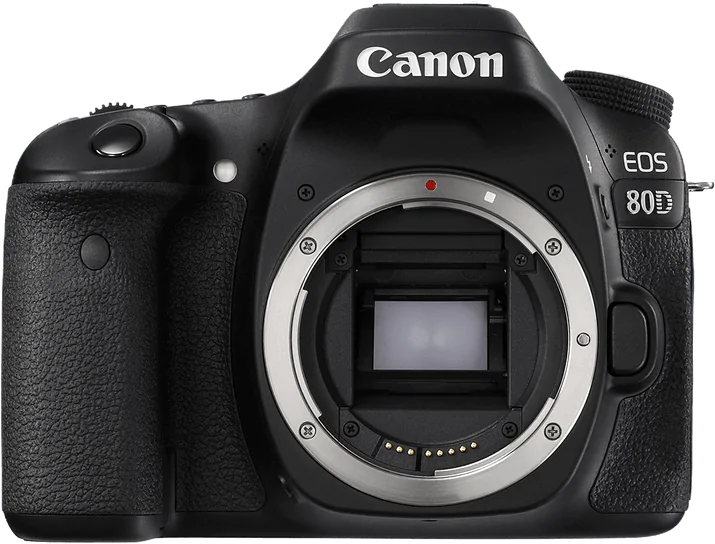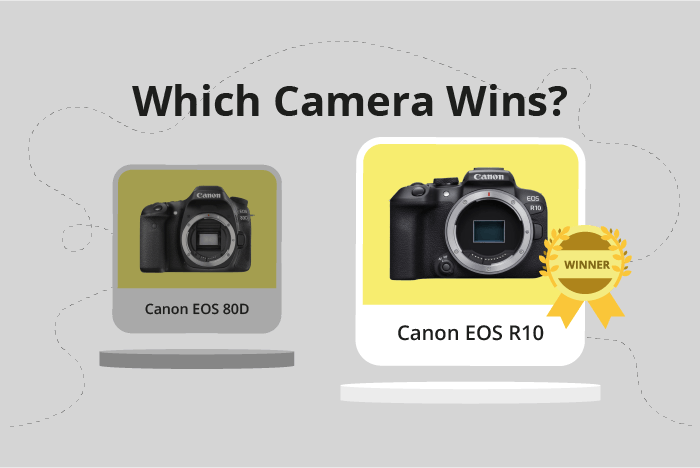Canon EOS 80D vs EOS R10 Comparison
Canon EOS 80D

Canon EOS R10

The Canon EOS R10 emerges as the winner with a score of 69/100, while the Canon EOS 80D scores 64/100. Both cameras share some common specifications, including their announcement and release years, 2016 and 2022, respectively. The launch prices also show a difference, with the EOS 80D priced at $1200 and the EOS R10 at $980.
The EOS R10 outperforms the EOS 80D in terms of size and weight, measuring 123 x 88 x 83mm and weighing 426g. In contrast, the EOS 80D measures 139 x 105 x 79mm and weighs 730g. The compact and lightweight design of the EOS R10 makes it a more convenient choice for photographers.
On the other hand, the EOS 80D is a DSLR camera, which may appeal to those who prefer the traditional optical viewfinder and more robust build associated with DSLRs. However, the EOS R10’s mirrorless design offers advantages such as faster autofocus and better video capabilities.
Taking all these factors into account, the Canon EOS R10 proves to be a superior camera in terms of size, weight, and performance. The EOS 80D may still appeal to certain photographers, but the R10 offers more modern features and better value for money.
Canon EOS 80D vs EOS R10 Overview and Optics
The Canon EOS R10 emerges as the winner in the optics comparison, scoring 71 out of 100, while the Canon EOS 80D scores 63. Both cameras share some common specifications, such as a 24-megapixel CMOS sensor, an APS-C sensor size, and the absence of image stabilization.
The EOS R10 outperforms the 80D in several aspects. Firstly, it has a faster shooting speed of 15 frames per second, compared to the 80D’s 7 frames per second. This faster shooting speed allows for capturing fast-moving subjects and action shots effectively. Secondly, the R10 features a more advanced Digic X processor, enhancing the camera’s overall performance, image quality, and speed. Lastly, the R10 has a significantly higher DXOMARK sensor score of 97, compared to the 80D’s score of 79, indicating better image quality and low-light performance.
On the other hand, the EOS 80D has a slight advantage in terms of megapixels, with 24.2 compared to the R10’s 24. However, this small difference is unlikely to impact image quality significantly. The 80D also features a Canon EF-S lens mount, which is compatible with a wide range of lenses.
Taking these factors into account, the Canon EOS R10 is the superior choice in terms of optics. Its faster shooting speed, advanced processor, and higher DXOMARK sensor score make it a more suitable option for photographers seeking better performance and image quality. The Canon EOS 80D, while still a good camera, falls short in these areas, with its only advantage being a minor difference in megapixels and a lens mount compatible with a wider range of lenses.
Canon EOS 80D vs EOS R10 Video Performance
The Canon EOS R10 outperforms the Canon EOS 80D in video capabilities with a score of 91/100, a significant 21-point lead over the 80D’s score of 70/100. Both cameras share some common video features, such as having built-in time-lapse functionality. However, there are key differences that make the R10 a superior choice for video recording.
The EOS R10 boasts a maximum video resolution of 4K (3840 x 2160) compared to the 80D’s Full HD (1920 x 1080) resolution. This higher resolution in the R10 provides more detailed and sharper video quality, which is essential for professional videographers and content creators. Additionally, the R10 has a higher maximum video frame rate of 120fps, double that of the 80D’s 60fps. This allows for smoother video playback and the ability to create impressive slow-motion footage.
While the EOS 80D lacks in comparison to the R10’s video capabilities, it still offers reliable Full HD video quality suitable for casual videographers and those who do not require 4K resolution. The 80D’s lower video score does not negate its usefulness for specific users and video projects.
The Canon EOS R10 excels in video capabilities with its higher resolution, faster frame rate, and overall better video performance. It is an ideal choice for professionals and content creators looking for top-notch video quality. On the other hand, the Canon EOS 80D remains a viable option for those who value a more budget-friendly camera with decent video capabilities. Ultimately, the choice between the two cameras depends on the user’s priorities and specific video requirements.
Canon EOS 80D vs EOS R10 Features and Benefits
The Canon EOS R10 wins the comparison with a feature score of 91 out of 100, while the Canon EOS 80D scores 70 points.
Both cameras share several specifications, including a 3-inch screen size, a screen resolution of 1,040,000 dots, touchscreen capability, flip screen, and WIFI connectivity. These common features provide users with a high-quality display and easy interaction with the camera settings and options.
The Canon EOS R10 surpasses the EOS 80D in one key aspect: it has Bluetooth connectivity. This feature allows for seamless remote control, file transfer, and other wireless functions, increasing convenience for photographers. The addition of Bluetooth gives the EOS R10 an advantage over the EOS 80D in terms of wireless functionality.
The Canon EOS 80D, however, does not offer any significant advantages over the EOS R10. The lack of Bluetooth connectivity is a notable drawback when comparing the two models. It does not possess any unique features that would make it a more attractive option for potential buyers.
Taking these points into account, the Canon EOS R10 emerges as the better camera due to its Bluetooth connectivity, which enhances its wireless capabilities. The Canon EOS 80D falls short in this aspect, making it a less appealing choice for photographers who prioritize seamless wireless functionality. Therefore, the EOS R10 is the more advantageous option for users seeking a camera with superior features.
Canon EOS 80D vs EOS R10 Storage and Battery
The Canon EOS 80D wins in the storage and battery category with a score of 43/100, compared to the Canon EOS R10’s score of 40/100. Both cameras have one memory card slot and accept SD, SDHC, and SDXC (UHS-I compatible) memory cards.
The EOS 80D outperforms the EOS R10 in battery life, offering 960 shots per charge with its LP-E6N battery, while the EOS R10 only provides 450 shots with its LP-E17 battery. This significant difference makes the EOS 80D a better choice for extended shooting sessions.
However, the EOS R10 has an advantage in terms of charging convenience, as it supports USB charging. This feature allows users to charge the camera using a power bank or other USB power sources, which can be handy during travel or outdoor shoots.
Despite the EOS R10’s USB charging capability, the EOS 80D’s superior battery life gives it an edge in the storage and battery comparison. Users who prioritize longer shooting times without the need to change batteries frequently will find the EOS 80D a more suitable option.
Canon EOS 80D vs EOS R10 – Our Verdict
Are you still undecided about which camera is right for you? Have a look at these popular comparisons that feature the Canon EOS 80D or the Canon EOS R10:

